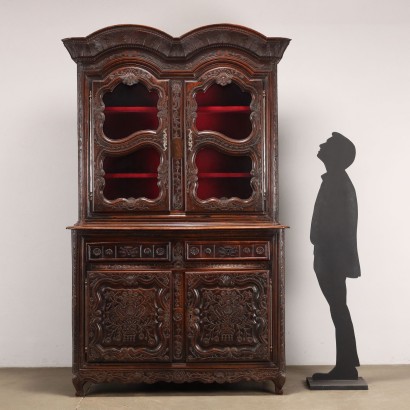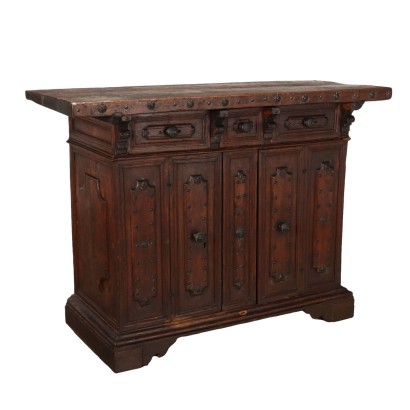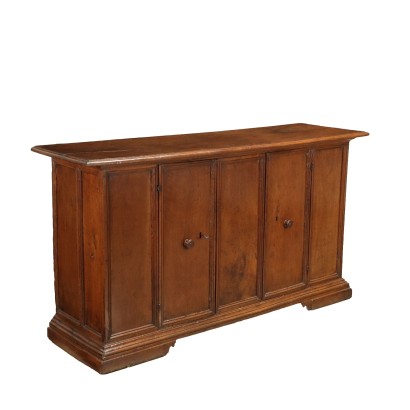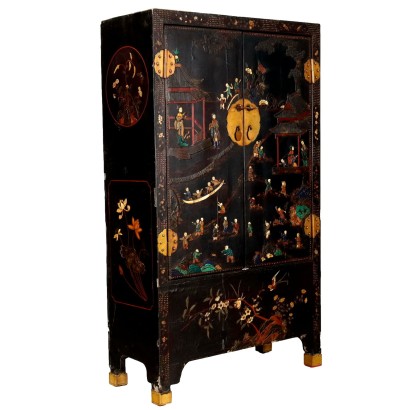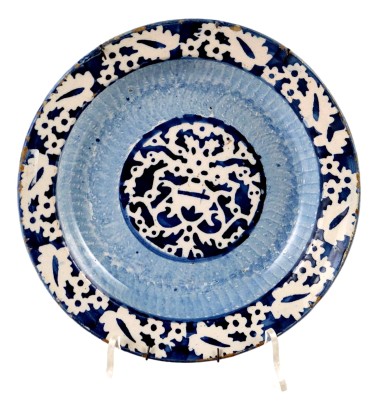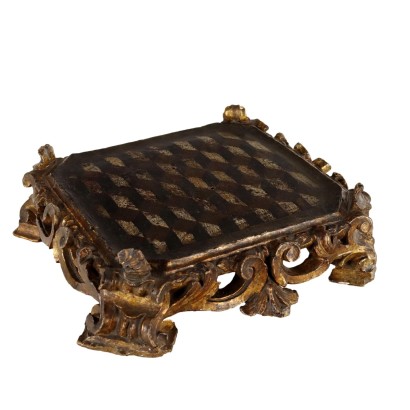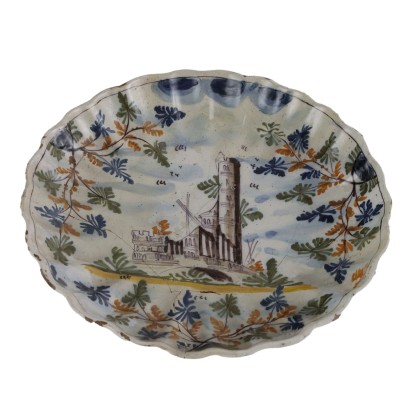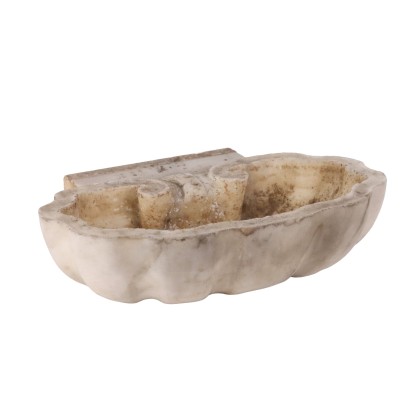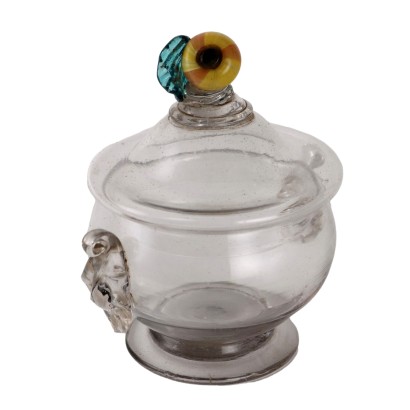Antique Cupboard Signed J. Baptiste Depouez Walnut Rennes '700 - Rennes, 1780s
Features
Rennes, 1780s
Age: 18th Century / 1701 - 1800
Origin: Rennes, Bretagna, France
Main essence: Walnut , Sessile Oak
Material: Carved Wood , Velvet , Blown Glass
Description
Cupboard with richly carved walnut stand, Rennes, 1880s. Rack characterized by a hat with a double arch and a pair of doors, each equipped with two panels with blown glass; the riser has undergone a modification over time, consisting in the removal of the shelves acting as plate racks to convert it into a bookcase. Lower body front with top and under-top band moved like a crossbow, the latter housing the two drawers, and pair of doors with carved tiles. Paneled sides, rounded uprights, wavy feet ending in a curl. Oak interior. On a decorative level we find fantastic animals such as phoenixes, Greeks, curls, rocaille-style motifs, phytomorphic and floral elements, rosettes and bows, all high quality carvings characterized by a calligraphic line. The piece of furniture is part of the Breton production of the Rennes area at the end of the 18th century, with a style derived from the arrival of the Parisian ornamental sculptors and the local interpretation of the "Bérain" style ornaments. Signature of the cabinetmaker and date of execution partially legible ("Faiet Par M(oi) I. Bap(tiste) Depo(uez) 178(?)"), placed in the reserve in the center of the riser. Jean Baptiste Depouez is among the best craftsmen of Rennes at the end of the century, knowing a certain number of furniture signed by him. With the exception of a piece of furniture dated 1799, we find, on all the furniture signed Depouez, the same panel decorated with a wreath of flowers, love knots and lambrequins, identifiable here on the front of the body doors. Finally, it is the terminal decoration called "cul-de-lampe", recognizable in the element repeated each time in the center of the low crosspieces, that attracts attention, because this very particular motif can be considered as a further personal signature of the cabinetmaker.
Product Condition:
Product which due to age and wear requires restoration and re-polishing. We try to present the real state of the furniture as completely as possible with photos. If some details are not clear from the photos, what is stated in the description applies.
Dimensions (cm):
Height: 253,5
Width: 159
Depth: 64
Additional Information
Age: 18th Century / 1701 - 1800
18th Century / 1701 - 1800Main essence:
Walnut
Walnut wood comes from the plant whose botanical name is juglans regia , probably originally from the East but very common in Europe. Light or dark brown in color, it is a hard wood with a beautiful grain, widely used in antique furniture. It was the main essence in Italy throughout the Renaissance and later had a good diffusion in Europe, especially in England, until the advent of mahogany. It was used for solid wood furniture and sometimes carvings and inlays, its only big limitation is that it suffers a lot from woodworm. In France it was widely used more than anything else in the provinces. In the second half of the eighteenth century its use decreased significantly because mahogany and other exotic woods were preferred.Sessile Oak
Under the name of oak or oak various types of woods derived from plants of the genus quercus are grouped. They are always resistant, hard and compact woods. Oak is lighter than oak, both are used for more rustic furniture or for the interiors of French and English antique furniture. In other processes it was gradually replaced by the advent of exotic woods considered more valuable since the 18th century.Material:
Carved Wood
Velvet
Blown Glass
Other customers have searched:
Credenza, mobile da cucina, armadio, stipo, dispensa, madia..
Ecco qualche spunto dal nostro blog e da FineArt per scoprire di più sul tema credenze:
Leggi di più
Una credenza che dialoga con il passato
Credenza doppio corpo, tesoro di intagli e decorazioni
Piccolo stipo, grande arredo
Stipo toscano a cavallo tra XVI e XVII
Credenza Barium di Luciano Frigerio
Credenza, Mathieu Befort Jeune, Parigi, terzo quarto XIX secolo
Mobile anni '60
Highboard '503' Gianfranco Frattini per Bernini
Mobile bar anni '40
Mobile Bar anni '40 '50, manifattura italiana
Sull'antiquariato in generale dai un'occhiata anche a:
Classic Monday: da un pezzo dei nostri magazzini alla storia dell'antiquariato
L'antiquariato dalla A alla Z: il Dizionario dell'Antiquariato
Il dizionario dell'antiquariato - Lastronatura
Il dizionario dell'antiquariato - Mascherone
Il dizionario dell'antiquariato - Natura morta
Il dizionario dell'antiquariato - Opificio
Il dizionario dell'antiquariato - Pastiglia
Il dizionario dell'antiquariato - Savonarola
Il dizionario dell'antiquariato - Rosone
Leggi di più
Una credenza che dialoga con il passatoCredenza doppio corpo, tesoro di intagli e decorazioni
Piccolo stipo, grande arredo
Stipo toscano a cavallo tra XVI e XVII
Credenza Barium di Luciano Frigerio
Credenza, Mathieu Befort Jeune, Parigi, terzo quarto XIX secolo
Mobile anni '60
Highboard '503' Gianfranco Frattini per Bernini
Mobile bar anni '40
Mobile Bar anni '40 '50, manifattura italiana
Sull'antiquariato in generale dai un'occhiata anche a:
Classic Monday: da un pezzo dei nostri magazzini alla storia dell'antiquariato
L'antiquariato dalla A alla Z: il Dizionario dell'Antiquariato
Il dizionario dell'antiquariato - Lastronatura
Il dizionario dell'antiquariato - Mascherone
Il dizionario dell'antiquariato - Natura morta
Il dizionario dell'antiquariato - Opificio
Il dizionario dell'antiquariato - Pastiglia
Il dizionario dell'antiquariato - Savonarola
Il dizionario dell'antiquariato - Rosone




